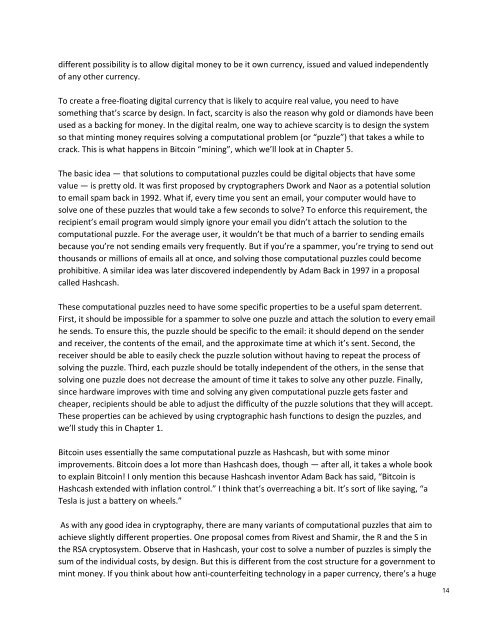Bitcoin and Cryptocurrency Technologies
1Qqc4BN
1Qqc4BN
Create successful ePaper yourself
Turn your PDF publications into a flip-book with our unique Google optimized e-Paper software.
different possibility is to allow digital money to be it own currency, issued <strong>and</strong> valued independently<br />
of any other currency.<br />
To create a free-floating digital currency that is likely to acquire real value, you need to have<br />
something that’s scarce by design. In fact, scarcity is also the reason why gold or diamonds have been<br />
used as a backing for money. In the digital realm, one way to achieve scarcity is to design the system<br />
so that minting money requires solving a computational problem (or “puzzle”) that takes a while to<br />
crack. This is what happens in <strong>Bitcoin</strong> “mining”, which we’ll look at in Chapter 5.<br />
The basic idea — that solutions to computational puzzles could be digital objects that have some<br />
value — is pretty old. It was first proposed by cryptographers Dwork <strong>and</strong> Naor as a potential solution<br />
to email spam back in 1992. What if, every time you sent an email, your computer would have to<br />
solve one of these puzzles that would take a few seconds to solve? To enforce this requirement, the<br />
recipient’s email program would simply ignore your email you didn’t attach the solution to the<br />
computational puzzle. For the average user, it wouldn’t be that much of a barrier to sending emails<br />
because you’re not sending emails very frequently. But if you’re a spammer, you’re trying to send out<br />
thous<strong>and</strong>s or millions of emails all at once, <strong>and</strong> solving those computational puzzles could become<br />
prohibitive. A similar idea was later discovered independently by Adam Back in 1997 in a proposal<br />
called Hashcash.<br />
These computational puzzles need to have some specific properties to be a useful spam deterrent.<br />
First, it should be impossible for a spammer to solve one puzzle <strong>and</strong> attach the solution to every email<br />
he sends. To ensure this, the puzzle should be specific to the email: it should depend on the sender<br />
<strong>and</strong> receiver, the contents of the email, <strong>and</strong> the approximate time at which it’s sent. Second, the<br />
receiver should be able to easily check the puzzle solution without having to repeat the process of<br />
solving the puzzle. Third, each puzzle should be totally independent of the others, in the sense that<br />
solving one puzzle does not decrease the amount of time it takes to solve any other puzzle. Finally,<br />
since hardware improves with time <strong>and</strong> solving any given computational puzzle gets faster <strong>and</strong><br />
cheaper, recipients should be able to adjust the difficulty of the puzzle solutions that they will accept.<br />
These properties can be achieved by using cryptographic hash functions to design the puzzles, <strong>and</strong><br />
we’ll study this in Chapter 1.<br />
<strong>Bitcoin</strong> uses essentially the same computational puzzle as Hashcash, but with some minor<br />
improvements. <strong>Bitcoin</strong> does a lot more than Hashcash does, though — after all, it takes a whole book<br />
to explain <strong>Bitcoin</strong>! I only mention this because Hashcash inventor Adam Back has said, “<strong>Bitcoin</strong> is<br />
Hashcash extended with inflation control.” I think that’s overreaching a bit. It’s sort of like saying, “a<br />
Tesla is just a battery on wheels.”<br />
As with any good idea in cryptography, there are many variants of computational puzzles that aim to<br />
achieve slightly different properties. One proposal comes from Rivest <strong>and</strong> Shamir, the R <strong>and</strong> the S in<br />
the RSA cryptosystem. Observe that in Hashcash, your cost to solve a number of puzzles is simply the<br />
sum of the individual costs, by design. But this is different from the cost structure for a government to<br />
mint money. If you think about how anti-counterfeiting technology in a paper currency, there’s a huge<br />
14









